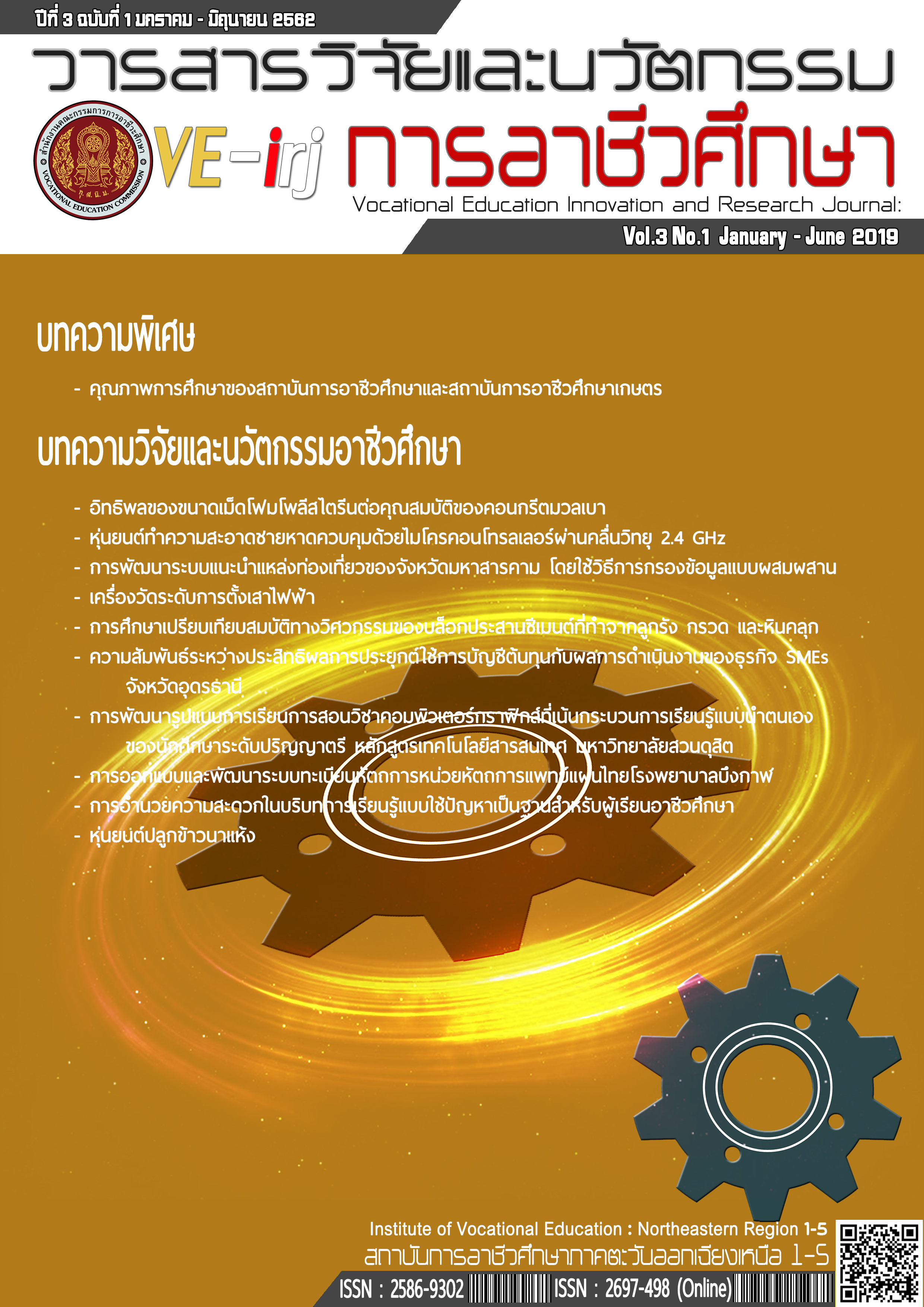Robots grow dry rice
Main Article Content
บทคัดย่อ
The study and development of a robot to grow dry rice is intended to Design and build robots to grow dry rice that can control the amount of distance and reduce costs. this study Using action research model presented in descriptive. When performing the performance test of the robot, grow dry rice Designed and built. Which uses a 48 volt electric motor, 300 watt power ,Battery capacity 12 volts 100 amps per size, 2 children, Head width about 50 cm, cut length 50 cm. Cut leaf length 50 cm. Test for rice cultivars, RD 10, rice stems, height 105-115 cm. Tilt angle 74-79 degrees, maximum yield 660 kg / rai, with 3 rai of rice cultivation, 1 rai each time, including 3 experiments. The results of the research showed that the experiment with the highest yield was the 3rd time at 580 kilograms. The speed used for growing rice 3 times averaged at 3 kilometers per hour. The minimum total loss is 3 times at 12.23 percent. The maximum working capacity per rai is 3 times at 30-40 minutes. The maximum planting speed is 30 rpm. Position movement Average at 86 percent. When comparing the efficiency of using robots to grow dry rice and manpower in rice cultivation, it was found that On the quantity of people per rai, use the amount of rice for planting 25 kg. If using a planting robot, it will use 10 kg of rice per rai. The length of time per rai is 30-40 minutes. If using a planting robot, it will take 20 minutes per rai. When comparing the efficiency of using robots to grow dry rice and using rice carts in general, the cost per rai In energy consumption, found that General machine The cost per rai is 2 liters of oil / 56.58 baht. The robot grows dry rice. The cost per rai is 1 hr / 5 baht.
Article Details
สงวนสิทธิ์ โดย สถาบันการอาชีวศึกษาภาคตะวันออกเฉียงเหนือ 1
306 หมู่ 5 ถนนมิตรภาพ หนองคาย-อุดรธานี ตำบลโพธิ์ชัย อำเภอเมืองหนองคาย จังหวัดหนองคาย 43000
โทร 0-4241-1445,0-4241-1447
ISSN : 3027-6861 (print) ISSN : 3027-687X (online)
เอกสารอ้างอิง
รศ. ดร. บุญเสริม กิจศิริกุล. (2003). "ปัญญาประดิษฐ์ เอกสารคำสอน วิชา 2110654" http://www.cp.eng.chula.ac.th/~boonserm/teaching/artificial.htm (28 กรกฎาคม 2560)
รศ. ดร. ประภาส จงสถิตย์วัฒนา , เอกสารการสอนเกี่ยวกับ โปรแกรม เชิงพันธุกรรม , ขั้นตอนวิธีเชิง พันธุกรรม และเอกสารอื่นๆ ที่ เกี่ยวข้อง, http://www.cp.eng.chula.ac.th/~piak/ (29 มิถุนายน 2560)
นายสาทิส เวณุจันทร์, (2548), วิจัยและ พัฒนาเครื่องหยอดข้าวขนาดเล็ก, เข้าถึงได้จาก , [ออนไลน์] http://www.doa.go.th/aeri/files/r esearch/48_smallriceharvester.Pdf. (3 ธันวาคม 2560)
ผศ.เสมอขวัญ ตันติกุล และผศ. ดร.สุเนตร สืบค้า, (2552), การพัฒนาเครื่อง เกี่ยวนวดข้าวคอรวงแบบติดตั้งกับรถ ไถเดินตาม, เข้าถึงได้จาก , [ออนไลน์] http://www.phtnet.org/downloa d/phtic-research/32.pdf,(3 ธันวาคม 2560)
Stuart J. Russell, Peter Norvig (2003) "Artificial Intelligence: A Modern Approach" (2nd Edition), Prentice Hall, New Jersey, ISBN 0-13-790395-2. (24 พฤษภาคม 2560).
Crevier 1993, pp. 47–49, who writes "the conference is generally recognized as the official birthdate of the new science." (22 กรกฎาคม 2560).
Russell & Norvig 2003, p. 17, who call the conference "the birth of artificial intelligence." NRC 1999, pp. 200–201. (24 พฤษภาคม 2560).


